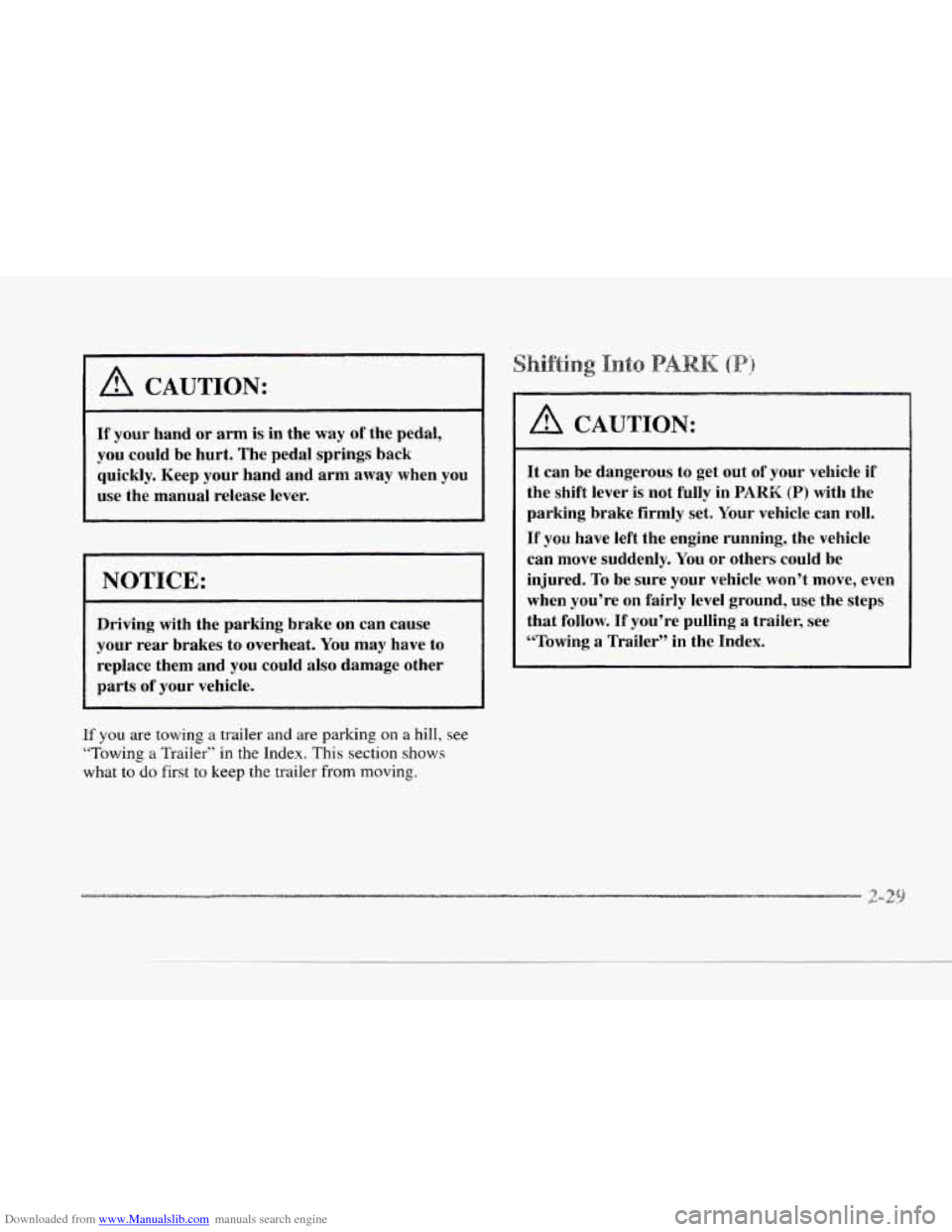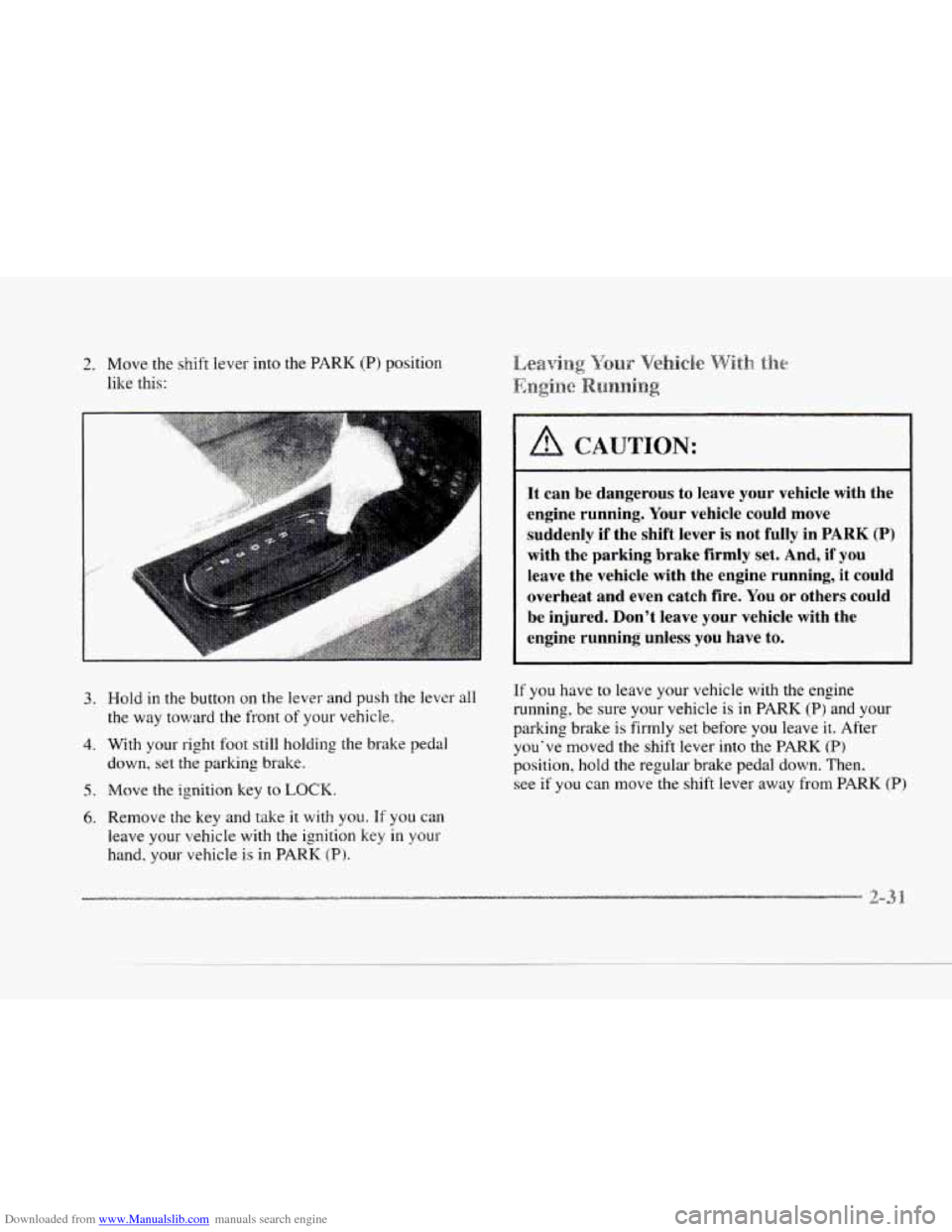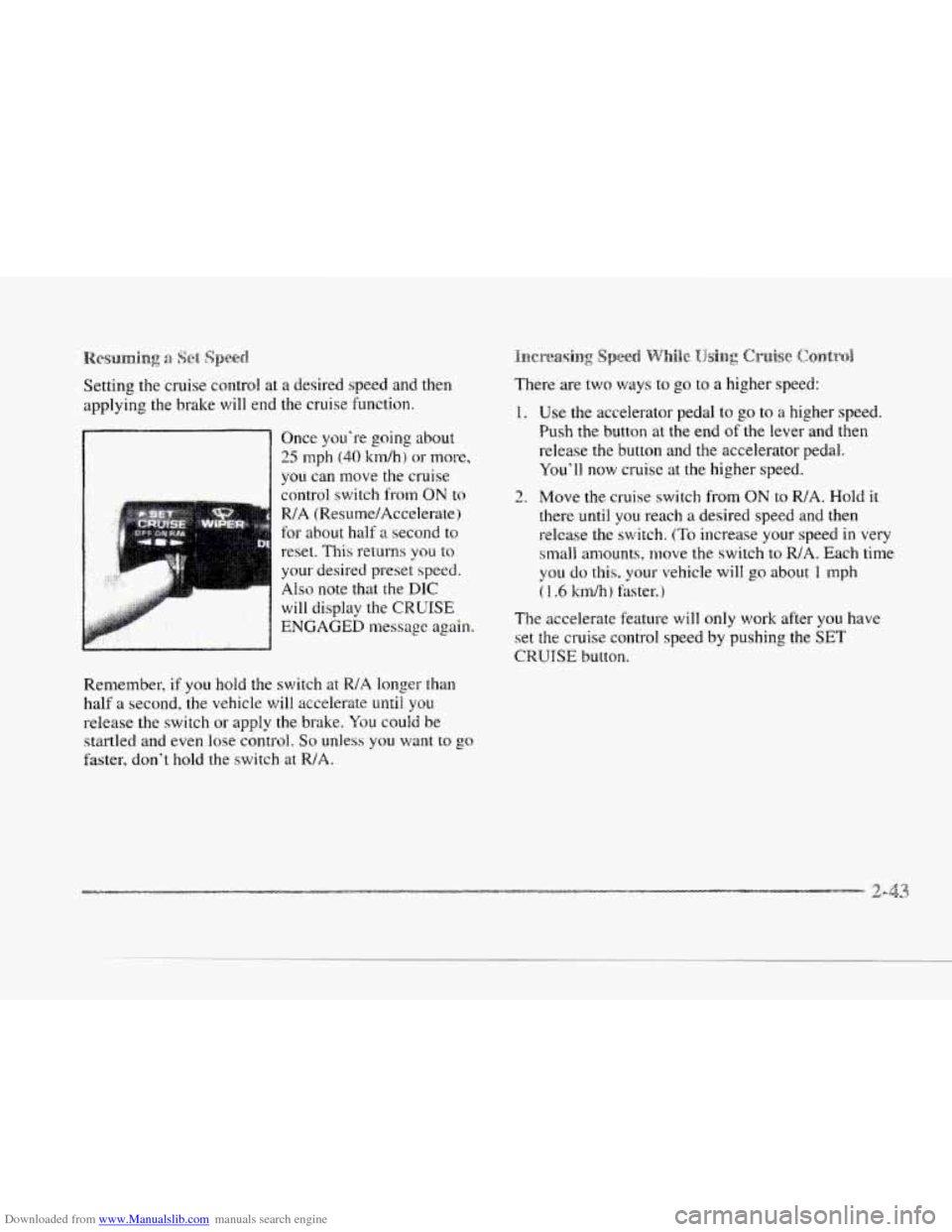Page 89 of 370
Downloaded from www.Manualslib.com manuals search engine c
Hold the regular brake
pedal down with your right
foot and
push down the
parking brake pedal with
your
left foot to set the
parking brake. If the
ignition is
on. the PARK
BRAKE
indicator light
should come
on. If it
doesn’t, you need to have
your vehicle serviced.
If the parking brake has not been fully released and
you try to drive off with the parking brake on. the
PARK BRAKE indicator light comes on and stays on.
See ’bParking Brake Indicator Light” in the Index for
more information.
When
you move out of PARK (P) or NEUTRAL (N),
if the engine is running, the parking brake should
release.
If it doesn’t. you can manually release the
parking brake. Reach under
the driver’s side of the
instrument panel
and pull
on the manual release lever, which is located
above the parking brake pedal. If the parking brake does
not release,
you should either drive to the nearest service
station or have your vehicle towed.
Page 90 of 370

Downloaded from www.Manualslib.com manuals search engine I A CAUTION:
If your hand or arm is in the way of the pedal,
you could be hurt. The pedal springs back
quickly. Keep your hand and
arm away when you
use the manual release lever.
NOTICE:
Driving with the parking brake on can cause
your rear brakes to overheat.
You may have to
replace them and
you could also damage other
parts
of your vehicle.
If you are towing a trailer and are parking on a hill, see
what to do first to keep the trailer from moving.
6b Towing a Trailer” in the Index. This section shows
A CAUTION:
It can be dangerous to get out of’ your vehicle if
the shift lever is not fully in PARK (P) with the
parking brake firmly
set. Your vehicle can roll.
If you have left the engine running, the vehicle
can move suddenly.
You or others could be
injured.
To be sure your vehicle won’t move, even
when you’re
on fairly level ground, use the steps
that follow.
If you’re pulling a trailer, see
“Towing a Trailer” in the Index.
Page 91 of 370
Downloaded from www.Manualslib.com manuals search engine 1. Hold the brake pedal down with your right hot.
2. Move the shift lever into the PARK (P) position
like this:
e Pull the lever tov~ard you.
0 Move the lever up as far as it will go.
1. With your right foot still holding the brake pedal
down,
set the parking bralte.
2. Move the ignition key to LOCK.
3. Remove the key and take it with you. If you can
leave your vehicle with the ignition key in
your
hand. your vehicle is in PARK (P).
1. Hold the brake pedal down with your right foot.
2-3
Page 92 of 370

Downloaded from www.Manualslib.com manuals search engine 2. Move the shift lever into the PARK (P) position
like this:
c
I
3.
c
... . .. ... . ..: . ..
4.
5.
6.
It can be dangerous to leave your vehicle with the
engine running. Your vehicle could move
suddenly
if the shift lever is not fully in PARK (P)
with the parking brake firmly set. And, if you
leave the vehicle with the engine running, it could
overheat and even catch fire. You or others could
be injured. Don't leave your vehicle with the
engine running unless you have to.
Hold in the button on the lever and push the lever all
the way toward the front of your vehicle.
With your right foot still holding the brake pedal
down,
set the garlung brake.
Move,
the ignition key to LOCK.
Remove the key and take it with you. If you can
leave your vehicle with the ignition key in
your
hand, your vehicle is in PARK (P}.
If you have to leave your vehicle with the engine
running, be sure your vehicle is in PARK
(P) and your
parking brake is firmly set before you leave it. After
you've moved the shift lever into the
PARK (P)
position, hold the regular brake pedal down. Then.
see if
you can move the shift lever away from PARK (P)
Page 93 of 370

Downloaded from www.Manualslib.com manuals search engine without first pulling it toward you (or, if you have the
console shift lever, without
first pushing the button). If
you can, it means that the shift lever wasn't fully locked
into PARK (Pj.
If you are parking on a hill and you don't shift your
transaxle into PARK
(P) properly, the weight of the
vehicle may put too much force
on the parking pawl in
the transaxle. You may find it difficult to pull the shift
lever out
of PARK (P). This is called "torque lock." To
prevent torque lock, set the parking brake and then shift
into PARK (P) properly before you leave the driver's
seat. To find out
how, see "Shifting Into PARK (P)" in
the Index.
If torque
lock does occur, you may need to have another
vehicle push yours
a little uphill to take some of the
pressure from the parking
pawl in the transaxle, so you
can pull the shift lever out of PARI' (P). Your
Cadillac has
a Brake-Transaxle Shift Interlock
(BTSIj.
You have to fully apply your regular brakes
bqfim you can shift from PARK (P) when the ignition is
in the RUN position. See "Automatic Transaxle" in the
Index.
If you cannot shift out of PARK (P), ease pressure on
the shift lever -- push the shift lever all the way into
PARK (P, and also release the shift lever button on floor
shift models as you maintain brake application. Then
move the shift lever into the gear
you want. (Press the
shift lever button before moving the shift lever.)
If you
ever hold the brake pedal down but still can't shift out of
PARK (P). try this: .
1.
2.
3.
4.
5.
Turn the key to OFF. Open and close the driver's
door to turn
oft the RAP feature.
Apply
and hold the brake until the end of Step 4.
Shift to NEUTRAL (N).
Start the vehicle and then shift to the drive pear
you want.
Have the vehicle fixed as soon as you can.
Page 95 of 370

Downloaded from www.Manualslib.com manuals search engine It’s better not to park with the engine running. But if you
ever have to, here are some things to know.
A CAUTION:
Idling the engine with the climate control system
off could allow dangerous exhaust into your
vehicle (see the earlier Caution under
“Engine Exhaust”).
Also, idling in a closed-in place can let deadly
carbon monoxide
(CO) into your vehicle even
if the fan switch is at the highest setting. One
place this can happen is
a garage. Exhaust -- with
CO -- can come in easily. NEVER park in a
garage with the engine running.
Another closed-in place can be
a blizzard. (See
“Blizzard” in the Index.)
A CAUTION:
It can be darlgerous to get out of your vehicle if
the shift lever
is not fully in PARK (P) with the
parking brake firmly set. Your vehicle
can roll.
Don’t leave your vehicle when the engine is
running unless you have to.
If you’ve left the
engine running, the vehicle can move suddenly.
You or others could be injured.
To be sure your
vehicle won’t move, even when you’re on fairly
level ground, always set your parking brake after
you move the shift lever to
PARK (P).
Follow the proper steps to be sure your vehicle won‘t
move. See ”Shifting Into
PARK (P)“ in the Index.
If you are parking on a hill and if you’re pulling a
trailer> also see “Towing a Trailer” in the Index.
Page 102 of 370
Downloaded from www.Manualslib.com manuals search engine c
With cruise control, you can maintain a speed of about
25 mph (40 km/h) or more without keeping your foot on
the accelerator. This can help on long trips. Cruise
control does not work at speeds below about 25 tnph
(40 km/h).
Cruise control shuts off when
you apply your brakes
8 Cruise control can be dangerous where you
can’t drive safely at a steady speed.
So,
don’t use your cruise control on winding
roads or in heavy traffic.
slippery roads. On such roads, fast changes
in tire tractiom can cause needless wheel
spinning, and
you could lose control. Don’t
@ Cruise control can be dangerous on
If your vehicle is in cruise control when the traction
control system begins to limit wheel
spin, the cruise
control
will automatically disengage. (See “Traction
Control System”
in the Index.) When road conditions
allow
~CXI to safely use it again. you may turn the
cruise control
back on.
Page 104 of 370

Downloaded from www.Manualslib.com manuals search engine c
c.
Setting the cruise control at a desired speed and then
applying the brake
will end the cruise function.
Once you’re going about
25 mph (40 kdh) or more,
vou can move the cruise
Lontrol switch
from ON to
R/A (Resume/Accelerate)
for about half
a second to
reset. This returns you to
your desired preset speed.
Also note that the DIC
will display the CRUISE
ENGAGED message again.
Remember,
if you hold the switch at RIA longer than
half
a second, the vehicle will accelerate until you
release the switch
or apply the brake. You could be
startled and even lose control. So unless you want to go
faster, don’t hold the switch at R/A.
There are two ways to go to a higher speed:
1. Use the accelerator pedal to go to a higher speed.
Push the button at the
end of the lever and then
release the button and the accelerator pedal.
You’ll now cruise at the higher speed.
2. Move the cruise switch from ON to WA. Hold it
there until you reach a desired speed and then
release the switch.
(To increase your speed in very
small amounts, nlove the switch to R/A. Each time
you
do this, your vehicle will go about 1 mph
( 1.6 kdh) faster.)
The accelerate feature will only work after you have
set the cruise control speed by pushing the
SET
CRUISE button.
2-43